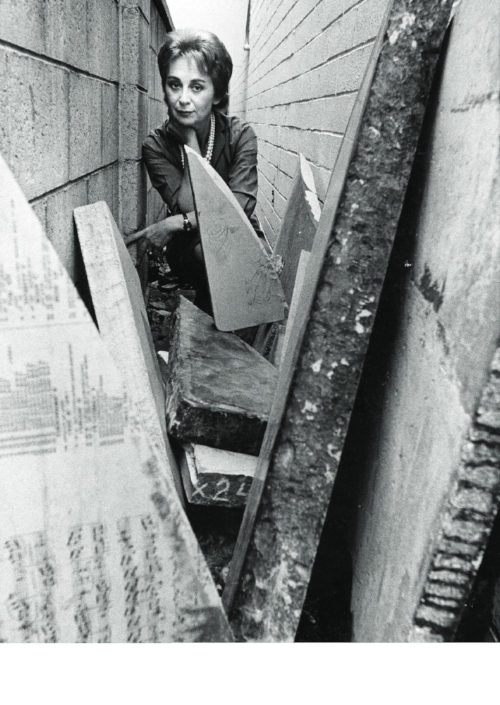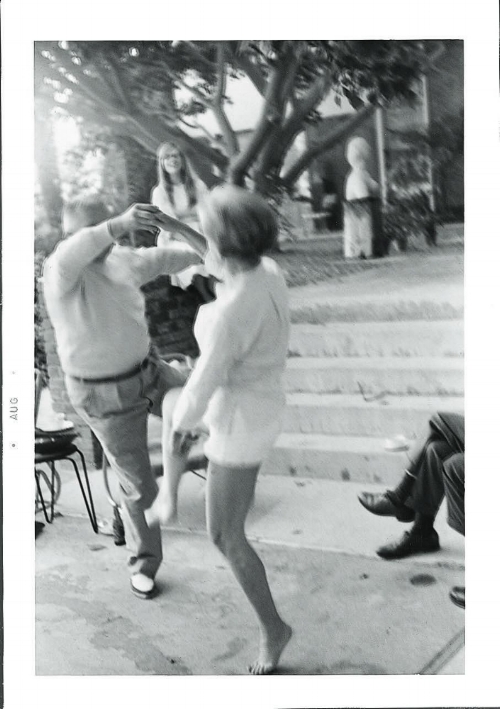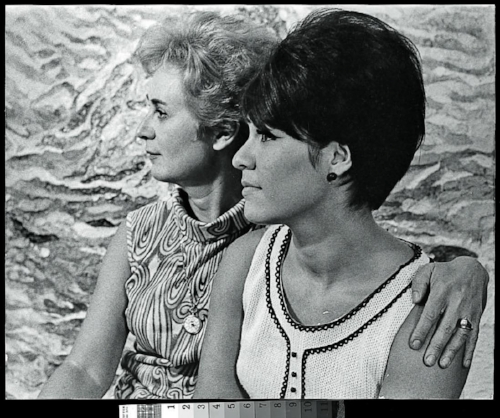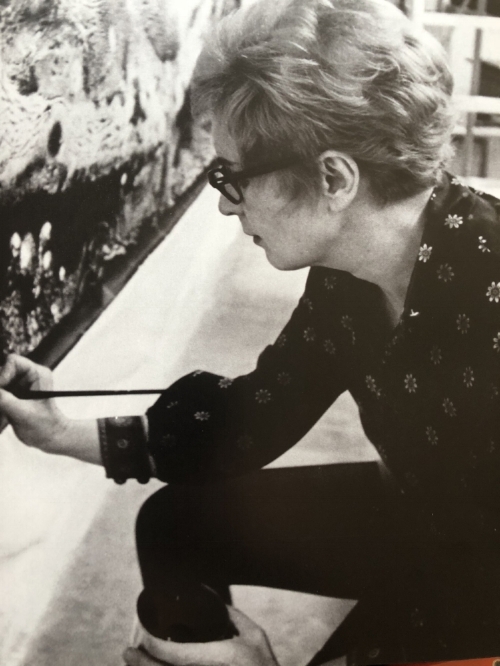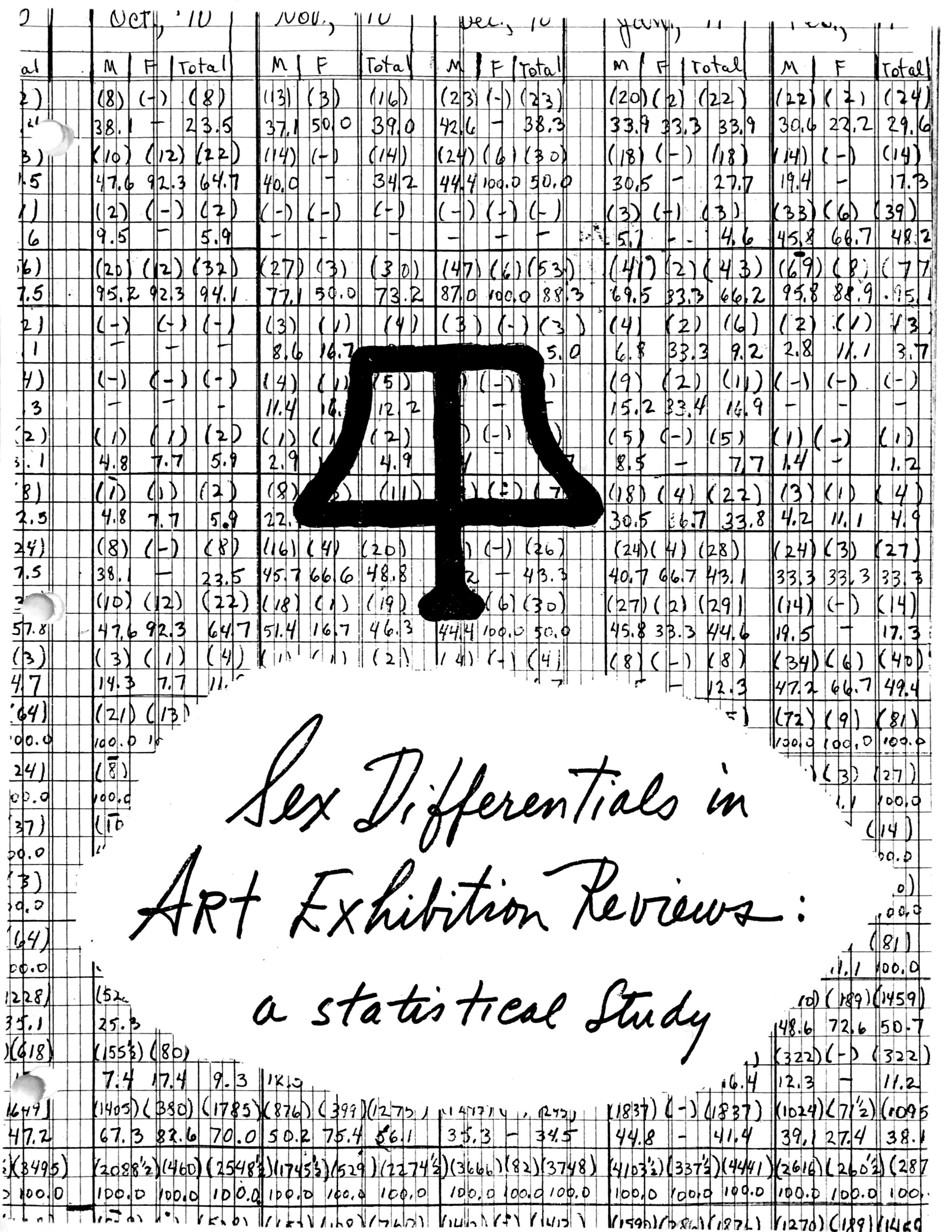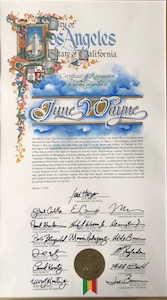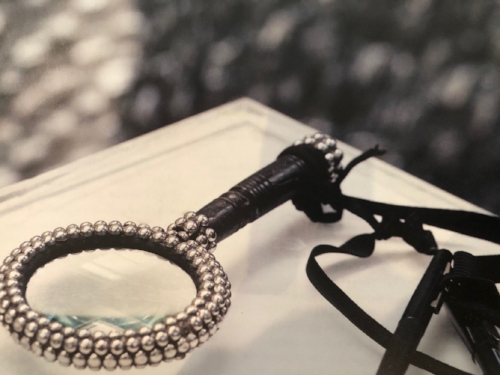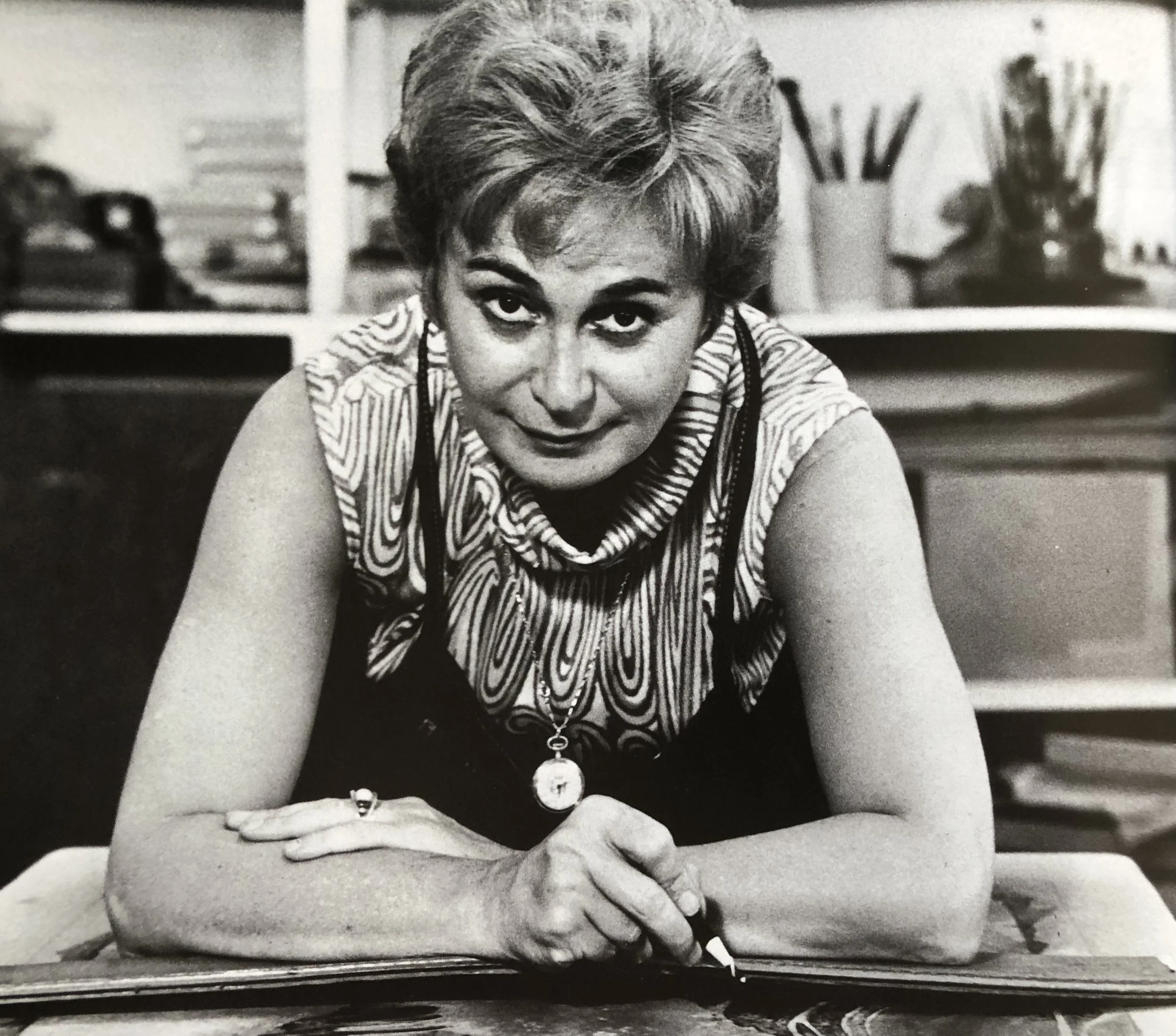June Wayne’s Bio
“When I was a nearsighted kid reading the Sunday comics (The Katzenjammer Kids), I noticed
that the colors were made of dots; red and yellow for orange, blue and yellow for green, red and blue for purple. The dots stunned me. Is everything really something else, or is this only in the comics?
A few years later, Sherlock Holmes became my hero because he noticed details from which he could draw the most amazing conclusions. From Holmes I learned how to notice and deduce…..which set me up for that great sound bite attributed to Enrico Fermi….roughly, that ‘you always know more about anything than you think you do. Just add everything you already know to everything you can observe and you’ll come within ten percent of accuracy about any subject at all.’ One has to practice noticing and deducing. As it happens, that is how art is made.” - June Wayne conversation with Roberta Loach, California Society of Printmakers, an Update, 2006.
June Wayne at the Tamarind Lithography Workshop , 1960's
June Wayne (March 7, 1918 - August 23, 2011)
June Wayne was born in Chicago. Passionate about the arts, she dropped out of high school at age 15, had her first painting exhibit at age 17. At 18, she traveled to Mexico City where she had been invited to exhibit at the Palacio de Bellas Artes. Shortly thereafter, she found employment as a painter for the WPA. Though she would leave Chicago, the powerful forces of nature she had seen as a young girl on the shores of Lake Michigan, would influence her future path and work.
By the 1940’s Wayne moved to California, and took courses in industrial design, intending to convert aircraft blueprints to drawings for the war effort. By night she was painting, and becoming an integral part of the California art scene.
In 1948, Wayne met Lynton Kisler who ran a small lithography studio. At the time lithography and printmaking in the US were generally regarded as more suitable for throwaway posters than for serious art. Wayne, however, saw bigger possibilities for the medium, and traveled to Paris to collaborate with master printer Marcel Durassier on a suite of her works inspired by the English poet John Donne.
Wayne’s stay in Europe persuaded her that lithography would allow fine artists to create multiples, expanding both the artistic palette and the affordability of quality works.
By 1959, high school dropout and autodidact Wayne had convinced the New York based Ford Foundation to underwrite residencies at her Hollywood studio for artists to collaborate with and learn from the master lithographers of Europe, and later the United States. Tamarind Lithography Workshop, named after the street where Wayne’s studio was located, brought over the next 10 years more than 150 artists into residence in this unique environment. Luminaries including Louise Nevelson, Sam Francis, Richard Diebenkorn, David Hockney, Josef and Annie Albers, Bruce Conner, Ed Ruscha, Francois Gilot, Rufino Tamayo, Philip Guston, and many others created seminal work in residence there. With will, charisma, and piercing intellect, Wayne's efforts transformed the world of printmaking.
By 1970, Wayne, always the experimentalist, was ready to turn over the reins, and arranged for the Tamarind workshop to be transferred to the University of New Mexico at Albuquerque as the Tamarind Institute. Wayne, now free of the administrative responsibilities of Tamarind, refocused her energies back on her own artwork.
Returning to Paris, Wayne renewed her friendship with Madeleine Jarry (1917-1982) the eminent and formidable Inspecteur principale du Mobilier National des Gobelins et de Beauvais, an association with roots in French royal tradition dating to the 15th century and supported heavily in their time by Colbert and Louis XIV.
June Wayne working alongside master weavers in France
When Jarry suggested that Wayne experiment with the tapestry medium, Wayne immediately recognized its sensuous and tactile nature, and was moved by the possibilities of its large scale. Several of Wayne’s lithographs formed the basis of the twelve tapestries which Wayne created in collaboration between 1970 and 1974 with the master weavers of France. Wayne’s early and close association with Dr. Jonas Salk (whom she introduced to Francois Gilot); the Jet Propulsion Lab; and others prominent persons in the scientific community, was no accident. By 1945, Wayne had grown increasingly fascinated with DNA, the forces behind tidal waves and other phenomena of nature, including the implications of the splitting of the atom. It was these themes which Wayne would explore in her tapestries and her later paintings.
Unlike artists who dropped off their works to be mass-produced in tapestry mills, Wayne spent weeks at a time alongside the master weavers of the great studios of France as they prepared and did their work. She hand selected the yarn, its texture, cut, thickness, and color. Some of the tapestries took a year to weave from the full size cartoons which Wayne insisted be used. When dissatisfied with the result, which happened more than once, Wayne would order the work destroyed. No more than four tapestries, usually fewer, were ever woven from one design.
Wayne, who had through her efforts at Tamarind Lithography Workshop, revolutionized the quality and status of print making, similarly severely limited the size of her own lithographic and print editions. She did this to maintain quality, and to emphasize that prints were another fine art worthy of the most important collections. Her own editions were generally produced in 10-20 numbered prints, with artist proofs. This made her prints far rarer than those usually associated with the print medium.
The 1000th lithograph produced at Tamarind in 1965 had been held back for Wayne’s creation. “At Last a Thousand” manifested her growing interest in the workings of the cosmos, showing an atomic explosion in interstellar space. From 1965 until her death at age 93 in 2011, Wayne created a body of painting, mixed media, and lithographic works, most concerned with big questions of the cosmos, our scientific origins, and the future and place of humanity in the universe.
"No artist explored the relationship between art and science more profoundly and persistently than Wayne"
Perhaps no artist explored the relationship between art and science more profoundly and persistently than Wayne did in these works. As the author Robert P. Conway notes, Wayne, “realized that the cosmic images that had inspired generations of poets had been superseded by a new vision of the universe that scientists were now discovering.” But as curator Jay Belloli observed, “She depicted scientific discoveries in poetic rather than illustrative ways.”
In mixed media works such as her legendary last work “Propeller”, “String Wave”; lithographs such as “Tenth Wave” and “Star Dust;” and tapestries including “Grand Vague Bleu” and “La Journeé des Lemmings” Wayne returned again and again to these large themes, often using techniques and colors, which she invented. Many of Wayne’s paintings were repainted on earlier canvases that were built up with thick, textured mixtures of gesso, gelatin, and paper. Wayne stated that the metallic leaf on many of these made each painting a reflective source that changed as one walked around them. “I thought of these pictures as pieces of planets, the way they might look if you could go from one planet to another, planet hopping as it were”.
Tenth Wave, a lithograph by June Wayne
Wayne was a fiercely independent individual who in her own words, “Ran on indignation”. She was an activist for womens’ causes, mentoring dozens of women artists and leaders in a seminar she founded in 1972 that came to be known as Joan of Art, this two years after ending her decade long run as director of Tamarind Lithography Workshop. Joan of Art focused on the practical aspects of empowering women to take on the unequal representation of women in the gallery and museum world. The women artists who participated in these workshops, and learned to deal effectively with contracts, negotiation, approach to critics and cultural institutions, described it as career and life changing, and went on at Wayne's insistence to lead their own Joan of Art seminars . In 1972 , Wayne commissioned the landmark 1972 study “Sex differentials in Art Exhibition Review: A Statistical Study” which showed in its 132 page study the degree of underrepresentation of women and provided indisputable proof of the inequities.
Still despite her leadership empowering women in the art world, Wayne would not allow herself to be categorized. “Some of my problems over the years stemmed from my inability to think of myself as any kind of minority, woman, Jew, artist, whatever”, she once said.
As then LA Times art critic William Wilson wrote in 1998, “Wayne’s uniqueness lies in her departures. She offers a fruitful alternative model for the artist. Never allowing a signature style to imprison her, like a creative scientist she investigates her ideals and passions even when they lead her out of the studio. She does more than make superior art in Los Angeles. She helped mold its larger culture."
Wayne’s works have been the subject of dozens of gallery exhibitions, and are held in major museum collections world wide, including the Museum of Modern Art, NY; the Los Angeles County Museum of Art; the Norton Simon Museum; the Bibliotheque Nationale de France, and many, many others. Hundreds of articles, reviews, and videos have covered her work. Recent important solo exhibits of her work were held in 2010 at the Art Institute of Chicago, and in 2014 at the Pasadena Museum of California Art. Getty Publications in association with the Norton Simon Museum published in 2013“Proof the Rise of Printmaking in Southern California” documenting the exhibit of the same name, much of it devoted to Wayne’s seminal influence on contemporary printmaking. The Museum of Modern Art will be including Star Shower from Stellar Winds (1979) in its 2019 appointment calendar.
MB Abram Galleries is pleased to represent the works of the June Wayne Collection and Wayne's estate.
June Wayne's significance and influence, while celebrated, is in our opinion only beginning its long arc of recognition. MB Abram Galleries welcomes a new generation of collectors, curators, and scholars, excited about June Wayne, experimentalist. As our science and exploration leads us into distant universes, we are confident that the art of June Wayne will be aboard.
All images (unless otherwise noted) © 2024 June Wayne Collection / Robin C. Park




